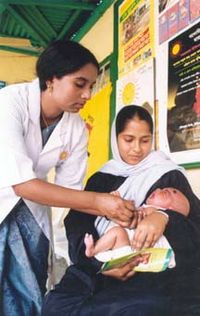
Photo from wikipedia
384 Background: Telemedicine utilization has increased in recent years, with widespread adoption during the COVID-19 pandemic. Literature has documented benefits of telemedicine in cancer care and symptom management; patients (pts)… Click to show full abstract
384 Background: Telemedicine utilization has increased in recent years, with widespread adoption during the COVID-19 pandemic. Literature has documented benefits of telemedicine in cancer care and symptom management; patients (pts) report satisfaction with telemedicine. Data on telemedicine utilization is lacking, and racial/ethnic differences in utilization and satisfaction are unknown among breast cancer pts. Methods: Two surveys, conducted in 2020 and 2021, collected data on telemedicine utilization and satisfaction among breast cancer pts enrolled in the Chicago Multiethnic Epidemiologic Breast Cancer Cohort. Telemedicine utilization (e.g., telephone call or video conference) during the COVID-19 pandemic was per self-report. Satisfaction was assessed using a 5-point Likert scale. Mixed-effects (ME) binary logistic regression was used to model utilization, and ME proportional odds regression was used to model satisfaction. Adjusted odds ratios (AOR) and 95% confidence intervals (CI) were calculated. Results: Of 1,260 respondents in 2020, 57.6% were ages 40-65, 72.2% were White, 22.3% were Black, 75.1% had private insurance, and 99% had early-stage breast cancer. Of 1,299 respondents in 2021, 58.6% were ages 40-65, 71.4% were White, 21.9% were Black, 77.6% had private insurance, and 98.9% had early-stage breast cancer. In 2020, 59.1% reported using telemedicine, while in 2021, 64.9% did. Black pts were most likely to have used telemedicine, followed by Asian, Hispanic, and White pts. In the adjusted ME models, Black pts were more likely than White pts to have used telemedicine (AOR 2.9, 95% CI: 1.6-5.4), while no differences in utilization were observed between Asian and White (AOR 2.1, 95% CI: 0.6-7.4) or Hispanic and White (AOR 1.7, 95% CI: 0.5-6.3) pts over time. In 2020, 90.3% reported somewhat to extreme satisfaction with telemedicine, and in 2021, 91.2% did. There were no racial/ethnic differences in satisfaction between Black and White (AOR 1.1, 95% CI: 0.7-1.7), Asian and White (AOR 0.4, 95% CI: 0.2-1.1), or Hispanic and White (AOR 0.5, 95% CI: 0.2-1.4) pts over time. Conclusions: In this multiethnic cohort of breast cancer pts, telemedicine utilization and satisfaction were high over time and across racial/ethnic groups. Furthermore, racial/ethnic minorities were more likely to have used telemedicine. Our findings suggest an important role for telemedicine in reducing barriers to care and promoting health equity in breast cancer pts.
Journal Title: Journal of Clinical Oncology
Year Published: 2022
Link to full text (if available)
Share on Social Media: Sign Up to like & get
recommendations!